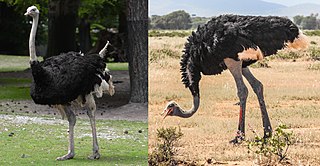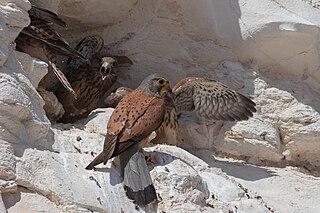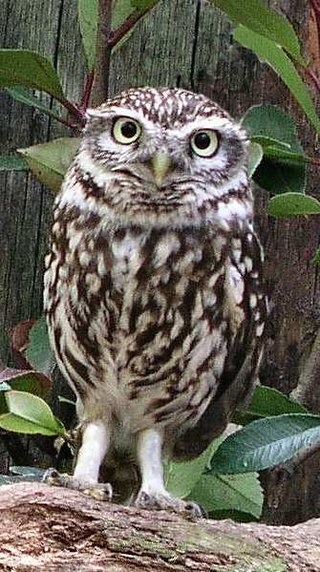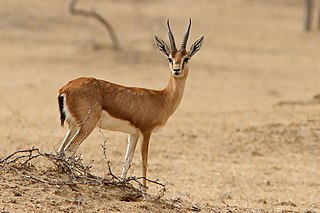
Hyenas or hyaenas are feliform carnivoran mammals belonging to the family Hyaenidae. With just four extant species, it is the fifth-smallest family in the order Carnivora and one of the smallest in the class Mammalia. Despite their low diversity, hyenas are unique and vital components of most African ecosystems.

The Neogene is a geologic period and system that spans 20.45 million years from the end of the Paleogene Period 23.04 million years ago (Mya) to the beginning of the present Quaternary Period 2.58 million years ago. It is the second period of the Cenozoic and the eleventh period of the Phanerozoic. The Neogene is sub-divided into two epochs, the earlier Miocene and the later Pliocene. Some geologists assert that the Neogene cannot be clearly delineated from the modern geological period, the Quaternary. The term "Neogene" was coined in 1853 by the Austrian palaeontologist Moritz Hörnes (1815–1868). The earlier term Tertiary Period was used to define the span of time now covered by Paleogene and Neogene and, despite no longer being recognized as a formal stratigraphic term, "Tertiary" still sometimes remains in informal use.

The Pliocene is the epoch in the geologic time scale that extends from 5.33 to 2.58 million years ago (Ma). It is the second and most recent epoch of the Neogene Period in the Cenozoic Era. The Pliocene follows the Miocene Epoch and is followed by the Pleistocene Epoch. Prior to the 2009 revision of the geologic time scale, which placed the four most recent major glaciations entirely within the Pleistocene, the Pliocene also included the Gelasian Stage, which lasted from 2.59 to 1.81 Ma, and is now included in the Pleistocene.

Hippopotamidae is a family of stout, naked-skinned, and semiaquatic artiodactyl mammals, possessing three-chambered stomachs and walking on four toes on each foot. While they resemble pigs physiologically, their closest living relatives are the cetaceans. They are sometimes referred to as hippopotamids.

Dinofelis is an extinct genus of machairodontine, usually classified in the tribe Metailurini. It was widespread in Europe, Asia, Africa and North America from 5 million to about 1.2 million years ago. Fossils very similar to Dinofelis from Lothagam range back to around 8 million years ago, in the Late Miocene.

The little owl, also known as the owl of Athena or owl of Minerva, is a bird that inhabits much of the temperate and warmer parts of Europe, the Palearctic east to Korea, and North Africa. It was introduced into Britain at the end of the 19th century and into the South Island of New Zealand in the early 20th century.

Struthionidae is a family of flightless birds, containing the extant ostriches and their extinct relatives. The two extant species of ostrich are the common ostrich and Somali ostrich, both in the genus Struthio, which also contains several species known from Holocene fossils such as the Asian ostrich. The common ostrich is the more widespread of the two living species, and is the largest living bird species. The extinct genus Pachystruthio from the Late Pliocene-Early Pleistocene of Eurasia is one of the largest birds ever.

Ostriches are large flightless birds. Two living species are recognised, the common ostrich, native to large areas of sub-Saharan Africa, and the Somali ostrich, native to the Horn of Africa.

The term kestrel is the common name given to several species of predatory birds from the falcon genus Falco. Kestrels are most easily distinguished by their typical hunting behaviour which is to hover at a height of around 10–20 metres (35–65 ft) over open country and swoop down on ground prey, usually small mammals, lizards or large insects, while other falcons are more adapted for active hunting during flight.

Chasmaporthetes, also known as hunting or running hyena, is an extinct genus of hyenas distributed in Eurasia, North America, and Africa during the Pliocene-Pleistocene epochs, living from 4.9 million to 780,000 years ago, existing for about 4.12 million years. The genus probably arose from Eurasian Miocene hyenas such as Thalassictis or Lycyaena, with C. borissiaki being the oldest known representative. The species C. ossifragus was the only hyena to cross the Bering land bridge into the Americas, and ranged over what is now Arizona and Mexico during Blancan and early Irvingtonian Land Mammal ages, between 5.0 and 1.5 million years ago.

Palaeospheniscus is an extinct genus of penguins belonging to the subfamily Palaeospheniscinae. These penguins are apparently not closely related to the modern genus Spheniscus.

Athene is a genus of owls, containing nine living species, depending on classification. These birds are small, with brown and white speckles, yellow eyes, and white eyebrows. This genus is found on all continents except for Australia, Antarctica, and Sub-Saharan Africa. An evolutionary radiation of 4 species is also present in the Solomon Islands.

Kolpochoerus is an extinct genus of the pig family Suidae related to the modern-day genera Hylochoerus, Phacochoerus, and Potamochoerus. It is believed that most of them inhabited African forests, as opposed to the bushpig and red river hog that inhabit open brush and savannas. There are currently eleven recognized species.

A gazelle is one of many antelope species in the genus Gazella. There are also seven species included in two further genera; Eudorcas and Nanger, which were formerly considered subgenera of Gazella. A third former subgenus, Procapra, includes three living species of Asian gazelles.

Eucyon is an extinct genus of medium omnivorous coyote-like canid that first appeared in the Western United States during the late Middle Miocene 10 million years ago. It was the size of a jackal and weighed around 15kg. It was one of the few North American mammals which invaded Eurasia about 6 million years ago, followed by the genus going extinct 3 million years ago. This genus is proposed to have given rise to genus Canis 6 million years ago.

Plesiogulo is a genus of prehistoric carnivore that lived from Miocene to Pliocene of Africa, Eurasia and North America. An ancestral relationship to the wolverine was once suggested, but it is no longer considered likely. However, some authorities still consider it a member of the Guloninae.
Africanacetus is an extinct genus of ziphiid cetacean known from skulls found in seafloor sediments of Late Miocene to Early Pliocene age off the coasts of South Africa and Brazil.
Panthera shawi is an extinct prehistoric cat, of which a single canine tooth was excavated in Sterkfontein cave in South Africa by Robert Broom in the 1940s. It is thought to be one of the oldest known Panthera species in Africa.
Albrecht Manegold is a German ornithologist and paleontologist. He is the curator of the vertebrate collection at the State Museum of Natural History Karlsruhe. He is known for contributions to the study of early passerine evolution. He has described extinct passerines and piciformes including the fossil treecreeper Certhia rummeli and the fossil woodpecker Australopicus nelsonmandelai.
Tyto richae is an extinct species of Tyto that lived in South Africa during the Early Pliocene, its fossils having been discovered in the Varswater Formation.















